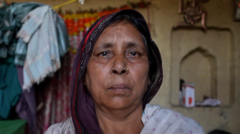A recent investigation by BBC Hindi has unveiled a troubling reality surrounding the tragic crowd crush at the Kumbh Mela, one of the world’s largest religious gatherings. While the official death toll currently stands at 37, the report indicates that the number of fatalities may be significantly higher, with at least 26 additional families receiving compensation for deaths linked to the incident, and 18 more victims reportedly going unrecognized by authorities.
On March 25, police from Uttar Pradesh traveled to Bihar, delivering cash payments to families affected by the disaster. One such case involved 62-year-old Tara Devi, whose family received 500,000 rupees ($5,758; £4,291), but was reportedly informed by officials that this sum was only the first part of a promised 2.5 million rupees.
The investigative report further emphasizes the opaque nature of the Uttar Pradesh government’s compensation process. In total, 35 victims’ families received 2.5 million rupees, but there are also numerous cases where families signed documents stating health issues were responsible for their loved ones' deaths, despite maintaining the deaths resulted from the crush. Furthermore, the investigation highlighted four separate crush incidents on the day that authorities had previously insisted were only one.
In meetings with over 100 families across 11 Indian states, the BBC corroborated 82 fatalities through extensive documentation, such as post-mortems, morgue slips, and eyewitness testimonies. Key locations of the crush included areas designated as Sangam Nose, among others, all of which were recorded with specific coordinates mapping the events.
The report revealed that discrepancies in record-keeping allowed the government to mitigate the scale of the tragedy, with individual cases leading to confusion among bereaved families regarding the official recognition of their grief. For instance, some families in proximity to the disaster area received compensation, while others with similar experiences did not. While the UP government boasts about the security measures deployed during the event, including AI-enabled CCTVs and a large police presence, many families reported no immediate help during the chaos.
Notably, cases of refused compensation were also recorded, as some families declined to sign what they deemed false documents attributing deaths to natural causes. Eyewitness accounts paint a picture of despair, as grieving relatives often went unassisted, forced to tend to bodies for extended periods amidst chaotic scenes.
Despite numerous inquiries to UP government officials to address discrepancies, communication remained largely unanswered, leaving many families in pain and uncertainty about receiving due acknowledgment and compensation for their lost family members. The burden of awaiting answers grows heavier for those left behind, as they battle to have their losses recognized in the wake of this overwhelming tragedy.


















